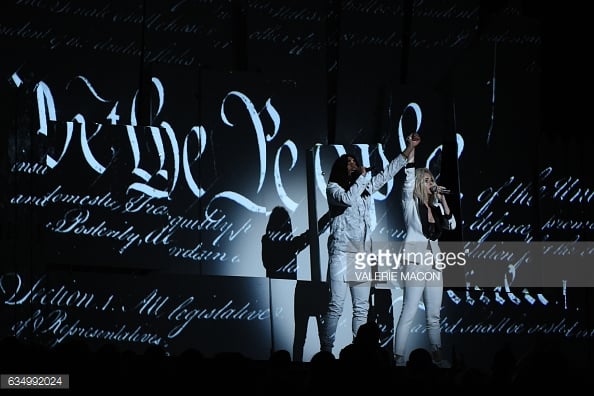Not too long ago I found myself at dinner with three young Frenchmen. Being myself, I asked them, “Do you listen to any American pop music?” They looked at each other, laughed, and replied simultaneously in a suave French accent, “Katy Perry.” I smiled at their response. We went to the living room after eating, and I put on “Firework,” “California Gurls,” and “Roar.” There ensued a lovely conversation rooted in our mutual love for Katy. I don’t think I’ll ever forget that Friday night. (It wasn’t that long ago.)
Everyone and their mother is now talking about Katy once again. There’s new music. She’s back, and she’s bold. At the Grammys she just performed her fresh hit, “Chained to the Rhythm.” I confess: I’m chained to this rhythm. But check it. Perhaps my bondage is part of the problem …
The song is not “art for art’s sake” or “dance pop” for dancing pops. This song has social repercussions. Some, Katy included, are calling it “purposeful pop.”
We gonna call this era Purposeful Pop. 👁 https://t.co/fCllqtlRTm
— KATY PERRY (@katyperry) February 10, 2017
katy’s new single #ChainedToTheRhythm is so, so, so great. a true bop & i’m so on board with this era of #purposefulpop. #GRAMMYs
— Tyler Oakley (@tyleroakley) February 13, 2017
The lyrics, the Grammy performance, and the music video leave no room for discussion: she has a message for America. This firework is about to explode.
We are chained, imprisoned, trapped in a bubble. We can’t imagine a way out because our imaginations have been poisoned by an endless cycle of entertainment and hedonistic pleasures. In Katy’s vision the U.S. has become “comfortably numb” to the sufferings of the poor.
Her Twitter description reads, “Artist. Activist. Conscious.” These three words are precisely the topic of “Chained to the Rhythm.” The track begins with a distant, alienated pop beat broken by the pensive lyrics, “Are we crazy?/Living our lives through a lens/Trapped in our white picket fence.” In her Grammy performance, Katy is standing behind this same fence, which separates her from the audience. She appears to be the only one on stage. She’s isolated from the people, alone, independent. The American dream of self-determination has left her wanting. The ideals ingrained in American youth–ideals of success, popularity, and autonomy–are entrapments. They distract us from the struggle taking place outside our confines. These ideals drug us into the false belief that everything is okay.
But everything’s not “okay.” Forty-three million U.S. citizens are living in poverty.1 There’s widespread racism, sexism, and political discord. Katy recognizes that she is not innocent in this dynamic of privileged indifference to the poor. She herself has contributed to the epidemic of socially apathetic entertainment. Merely turn to “Last Friday Night” to see how she seems to perpetually inhabit a “black out blur” of sex, alcohol, and maxed out “credit cards.” All’s fun and games until someone gets hurt; but the U.S.A. has been hurting since her birth in 1776,2 and somehow few seem to notice.
The Grammy performance is Katy showing us her conscientization to social reality. She begins behind the fence and progressively breaks free from its confines. It is a symbolic movement from individualism to togetherness, from selfish obliviousness to communal consciousness, from “Last Friday Night” to this very song. Throughout the performance, chains break apart, fences fall, and people unite. By the end Katy is standing with her co-singer Skip Marley under the banner “We the People.” A rebellion of love has taken place, and the only thing left to do is stand triumphantly hand in hand.
The stage performance meshes well with the wildly popular lyric video. The most provocative scene in that video shows a hamster resting on a couch. The cute, furry pet is watching a t.v. show in which another hamster is endlessly spinning around his wheel. The point is clear. Entertainment is meaninglessly circular. We listen to the same songs, we watch the same shows, we go to the same movies. The media changes in kind and in title, but its essence is vacuous and stupefying. Most are satisfied with bread and circuses, never considering the “more” to life in society.
“Chained to the Rhythm” is calling for a revolution in popular culture. It’s a radical reclaiming of the fact that music can change both individuals and nations. Echoing the protest music of the 20th century, “Chained” takes the next step of questioning pop’s own complacency in a world that hungers and thirsts for justice. It seeks a popular culture that is truly popular–that is, that represents the principles of “liberty, equality, and fraternity.” Those young Frenchmen would be proud. I hope they’re still listening.
.@katyperry trying to imitate anyone? #PurposefulPop #ChainedToTheRhythm pic.twitter.com/I8ofTKU8eW
— The Jesuit Post (@TheJesuitPost) February 16, 2017
- http://www.census.gov/library/publications/2016/demo/p60-256.html ↩
- and, of course, before ↩


